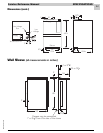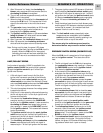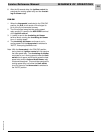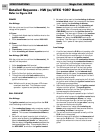
SPECIFICATIONS Magic-Pak: HW/HWC
2-8
SRM-HW/HWC 2/99
8. The 24-volt signal will only be supplied to the limit
switch circuit through pin 6 of the 6-pin ignition wire
harness and to the pressure switch circuit through
pin 2 of the 6-pin ignition wire harness.
9. The system will repeat this sequence until the
pressure switch closes and the 24-volt signal is
restored at pin 5 of the 6-pin ignition wire harness.
FAILED FLAME SENSE/TRIAL FOR IGNITION
When the pressure switch closes and a 24-volt signal
is sent to pin 5 of the 6-pin ignition wire harness, the
spark ignition cable terminal and pin 4 of the 6-pin
ignition wire harness energize.
1. As spark voltage is supplied to the ignitor elec-
trodes, the gas valve opens and this causes the
burners to ignite.
2. The ignition control continues to energize spark
voltage until a flame sense signal is supplied to the
flame terminal on the ignition control.
3. If a flame sense signal is not received at the flame
terminal on the ignition control, the spark igni-
tion cable terminal remains energized for 10
seconds.
4. After the 10-second trial for ignition, the ignition
control de-energizes the spark ignition cable
terminal and pin 4 of the 6-pin ignition wire harness.
This causes the gas valve to close and the elec-
trode spark to stop.
5. Once the 24-volt signal is sent to pin 4 of the 6-pin
ignition wire harness, a 30-second circulating air
blower “on” delay starts. After the delay is timed
out, the circulating air blower starts.
6. After the spark ignition cable terminal de-ener-
gizes, the ignition control initiates a 30-second
combustion blower inter-purge delay.
7. After 30-second inter-purge, the ignition control
energizes the spark ignition cable terminal and
pin 4 of the 6-pin ignition wire harness. If the flame
sense signal is received at the flame terminal of the
ignition control, the unit continues heat call.
8. If the flame sense signal is not received, the system
goes through three trials following the above
sequence.
9. After three trials, the system goes into lockout and
only the high limit switch circuit and pressure
switch circuit remain energized during the 60-
minute lockout period.
10. If the flame sense is lost during the heat cycle, the
gas valve de-energizes immediately and the
system goes into the trial sequence.
CALL FOR COOLING
Line Voltage
1. L2 power passes through the fixed closed L2-T2
terminals on the contactor to the RUN terminal of
the compressor and the COMMON terminal of the
capacitor.
2. L1 power is sent to the L1 terminal of the contactor.
When the Y signal energizes the contactor, the T2
terminal becomes energized. L1 power is sent to
the compressor COMMON terminal and the
condenser fan. This energizes the compressor
and condenser fan motors.
3. When pin 1 (Y terminal) of the 5-pin thermostat
harness receives a 24-volt signal from the thermo-
stat, a 5-second circulating air blower delay
starts.
4. After the 5-second delay, the ignition control
energizes the cooling speed relay. This sends L1
power to the ACB COOL terminal of the ignition
control.
5. L1 power is sent to the circulating air blower
terminal block, energizing the circulating air
blower motor.
6. When the R, Y and G circuit is interrupted by the
thermostat, the contactor is immediately de-
energized. This interrupts L1 power to the com-
pressor and condenser fan motors, stopping
both.
7. The ignition control starts a 90-second circulat-
ing air blower “off” delay, after which the ACB
COOL terminal de-energizes. This interrupts L1
power to the circulating air blower motor, causing
it to stop.
Low Voltage
1. The thermostat energizes the R, Y and G circuit,
sending a 24-volt signal to the contactor coil and to
pin 1 of the 5-pin thermostat harness connected to
the ignition control.
2. The contactor closes immediately upon receiving
the 24-volt signal, causing the compressor and
condenser fan motors to start.
3. The 24-volt signal is also sent to pin 1 of the 5-pin
thermostat harness, initiating a 5-second circulat-
ing air blower “on” delay.
4. After the 5-second delay, the ignition control
energizes the cooling speed relay and the circulat-
ing air blower starts.
5. When the cooling call is satisfied, the thermostat
interrupts the R, Y and G circuit. The contactor
de-energizes immediately, causing the compressor
and the condenser fan to stop. The ignition
control starts a 90-second circulating air blower
“off” delay.


















